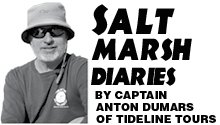On an island surrounded by saltwater, Fresh water is essential to life
 The older, bigger white dog walked straight ahead, claws rhythmically scratching the pavement. The younger, smaller black dog excitedly zigzagged, bouncing each way on the end of her leash. The heads of both dogs scanned left and right, ears perked. A squirrel crossed the road ahead, evoking a bark attack. Besides the regular claw scratching of pavement and the irregular barks, the streets of Folly were quiet at 7 a.m.
The older, bigger white dog walked straight ahead, claws rhythmically scratching the pavement. The younger, smaller black dog excitedly zigzagged, bouncing each way on the end of her leash. The heads of both dogs scanned left and right, ears perked. A squirrel crossed the road ahead, evoking a bark attack. Besides the regular claw scratching of pavement and the irregular barks, the streets of Folly were quiet at 7 a.m.
The walk took us up East Erie Avenue until it dead-ended into a bootleg right turn. Here the salt marsh meets the street. Multiple pothole repairs patch the pavement, which suggests a flooded street during extra high tides. Native plants show a rapid transition from marsh fringe varieties near the road to low marsh species down the bank just feet away from the pavement. Here on both sides of Erie, drainage ditches sit sprouted with new spring growth. A similar plant transition occurs here. Smooth cord grass (spartina alterniflora) grows in the deepest part of the ditches. Black needlerush (juncus roemerianus) gives way to salt marsh aster (aster tuifolius) and marsh orach (atriplex patula).
Within the width of the drainage ditch, indicator plant species transition from a low marsh environment to a high marsh, then to a marsh fringe plant assemblage. The plants tell the story. They tell me that tidal salt water regularly floods these drainage ditches.
Every naturally occurring Lowcountry coastal island and hammock tells a similar story. Just above the mean high tide level, a small change in elevation creates a large change in plant diversity. This rapid change marks the saltwater-freshwater interface. Fresh water and salt water don’t mix well. The less-dense fresh water actually floats on top of more-dense salt water. On islands and hammocks surrounded by the salt marsh, the fresh groundwater forms a lens that’s thicker in the middle of the island and thins where the fresh water-salt water plant transition occurs.
The thicker middle part of the lens supports cedar, oak, pine, and palmetto trees along with sweet grass. As a stop on my Salt Marsh Adventure, I point out these plant transitions and discuss the fresh groundwater lens. Sometimes I ask my guests how an island surrounded by saltwater ends up with fresh ground water. Moms and dads furrow their brows, considering complicated groundwater pathways. Usually the 5th grader on board answers “rain!” Yep, rain.
Once home, the older, bigger white dog walked up the 20 steps to the porch one at a time. The younger, smaller black dog climbed up the steps to the house in five bounds, and then raced to the water bowl.
Captain Anton Dumars owns and operates Tideline Tours located at 103 East Cooper on Folly Beach. Come by for a visit or sign up for a Tideline Adventure! Visit www.tidelinetours.com or email Anton at saltmarshadventure@gmail.com or call 843-813-5009.

